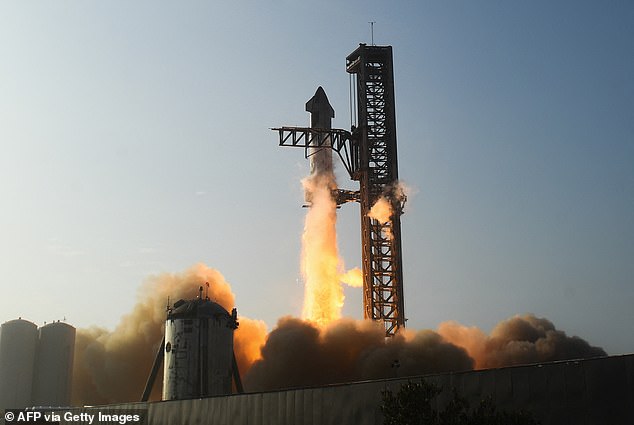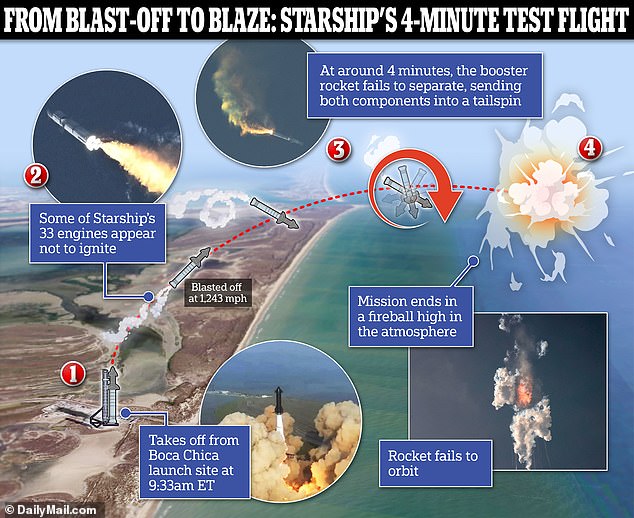Elon Musk says Starship will launch by FRIDAY – after the 4/20 maiden voyage saw the rocket explode four minutes into flight
>
Elon Musk announced that SpaceX has received approval to launch a Starship vehicle that could lift off on Friday, six months after the first flight of the giant rocket.
Starship is considered the largest and most powerful rocket in the world. It consists of a Super Heavy Boost and a rocket. It last took off on April 20 on a mission that ended with it exploding in the air after four minutes of flight.
The mission was supposed to see the 395-foot-tall vehicle explode 150 miles into the atmosphere before sailing for an hour and crashing into the Pacific Ocean, but SpaceX was forced to activate its flight termination system.
The announcement comes as SpaceX was awaiting final regulatory approval by the Federal Aviation Administration (FAA), which was conducting an environmental review of the previous prototype.
Elon Musk announced on Monday that SpaceX has received approval to launch a Starship vehicle that could lift off on Friday

Starship is considered the largest and most powerful rocket in the world, which will be used to colonize Mars. It last took off on April 20 on a mission that ended with it exploding in the air four minutes after flight.
The FAA must issue a launch license for a second test.
The regulatory body completed a safety review of Starship in October, but the project still needs approval from the U.S. Fish and Wildlife Service for a license to be granted.
SpaceX posted on the X website on November 10 that it expects to conduct the second flight test as early as November 17, pending regulatory approval.
In addition to waiting for approval, the company is working to repair the launch pad that was destroyed during the first flight.
Musk shared on November 13 that this approval must happen in time for SpaceX to meet this deadline.
“We have just been informed that launch approval should occur in time for the launch on Friday,” Musk wrote in a post on X.
This massive rock consists of the Super Heavy Booster and Starship, capable of releasing 16.7 million pounds of thrust upon liftoff, more than twice the thrust of the Saturn V rockets used to send the Apollo astronauts to the moon.

Elon Musk’s Starship rocket lifted off from South Texas at 9:33 a.m. ET in a maiden flight that would have seen it complete a circuit close to Earth, but SpaceX pulled the trigger that exploded the Starship into the air when the two stages failed to separate.
Friday’s flight is expected to follow the same guidelines as in April, but the world hopes to see a different result.
On April 20, the rocket ignited its engines at 9:33 a.m. ET while parked on the launch pad in Boca Chica, Texas.
The mission got off to a promising start as the spacecraft traveled at 1,242 miles per hour across the sky, climbing higher and higher with every second.
The cheering inside the control room got louder and louder as the spacecraft made its way into space.
The rocket was preparing for the separation stage at the three-minute mark two minutes after launch, said John Innsbrucker, SpaceX’s principal integration engineer.
The main engine stopped at 2 minutes and 51 seconds as planned, but the upper stage cone flipped back toward Earth, and the rocket entered a spin state at three minutes and 31 seconds.
However, the SpaceX team has not yet given up on the mission, indicating that they are waiting for the separation stage, even though the rocket was rotating in circles.
“It appears that we have seen the beginning of the flip, but clearly we can see from the ground cameras that the entire spacecraft assembly is continuing to rotate,” Innsbrucker said.
“We should have broken up by now obviously. This doesn’t seem to be a symbolic situation.”
At three minutes and 59 seconds, a fireball shot out from the Super Heavy, and the pile was obliterated in the air.
The live broadcast extended to the teams in the control room cheering the missile’s success.
The company’s leadership — including Musk — has repeatedly stressed the experimental nature of the launch and said any outcome that involves the spacecraft exiting the launch pad will be successful.
(Tags for translation)dailymail
